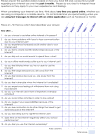The Problematic and Risky Internet Use Screening Scale (PRIUSS) for Adolescents and Young Adults: Scale Development and Refinement
- PMID: 24882938
- PMCID: PMC4035908
- DOI: 10.1016/j.chb.2014.01.035
The Problematic and Risky Internet Use Screening Scale (PRIUSS) for Adolescents and Young Adults: Scale Development and Refinement
Abstract
Problematic Internet use (PIU) is a growing health concern among adolescents and young adults. The purpose of this mixed-methods study was to develop and refine a theoretically-grounded and psychometrically-validated assessment instrument for PIU specifically tailored to adolescents and young adults. An item pool was developed using concept mapping and a review of the literature, and administered to 714 students from two universities between 18 and 25 years of age. Exploratory and confirmatory factor analyses were used in a development subsample (n=500) to construct the scale. A cross-validation sample (n=214) was used to confirm the scale's reliability. The Problematic and Risky Internet Use Screening Scale (PRIUSS) is an 18-item scale with three subscales: Social Impairment, Emotional Impairment, and Risky/Impulsive Internet Use. Based on its strong theoretical foundation and promising psychometric performance, the PRIUSS may be a valuable tool for screening and prevention efforts in this population.
Keywords: Internet use; concept mapping; problematic Internet use; psychometrics; scale development; screening.
Conflict of interest statement
The authors do not have any financial disclosures nor conflicts of interest to report.
Figures
References
-
- Anderson KJ. Internet use among college students: An exploratory study. Journal of American College Health. 2001;50(1):21–26. - PubMed
-
- Brown MW, Cudeck R. Alternative ways of assessing model fit. In: Bollen KA, Long JS, editors. Testing structural equation models. Newbury Park, CA: Sage; 1993. pp. 136–162.
-
- Caplan SE. Problematic Internet use and psychosocial well-being: development of a theory-based cognitive-behavioral measurement instrument. [Article] Computers in Human Behavior. 2002;18(5):553–575.
-
- Covell K, Dion K, Dion K. Gender differences in evaluations of tobacco and alcohol advertisements. Canadian Journal of Behavioral Sciences. 1994;26:404–420.
Grants and funding
LinkOut - more resources
Full Text Sources
Other Literature Sources



